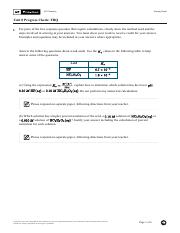Conquering AP Chemistry Unit 9: Your Guide to Success
Are you ready to tackle the challenges of AP Chemistry Unit 9? This comprehensive guide will equip you with the knowledge and strategies you need to conquer the Unit 9 progress check and excel in this crucial section of the AP Chemistry curriculum.
Unit 9 in AP Chemistry typically focuses on applications of thermodynamics, including concepts like Gibbs Free Energy, spontaneity, and equilibrium. This unit builds upon earlier concepts of enthalpy and entropy, weaving them together to predict the feasibility of reactions under different conditions. The Unit 9 progress check serves as a critical assessment of your understanding of these fundamental principles, evaluating your ability to apply them to solve complex chemical problems. Mastering this unit is essential for a strong foundation in thermodynamics and achieving a high score on the AP Chemistry exam.
Historically, thermodynamics has been a cornerstone of chemical understanding, allowing scientists to predict reaction behavior and design efficient chemical processes. The concepts covered in Unit 9, specifically, provide a powerful framework for analyzing the spontaneity and equilibrium of reactions. The progress check within Unit 9 aims to ensure students have grasped these vital concepts and are prepared to tackle more advanced topics in chemistry.
The significance of the AP Chemistry Unit 9 progress check lies in its assessment of essential thermodynamic principles. These principles are not only crucial for success in the AP exam but also fundamental to understanding a vast array of chemical phenomena. Issues students may encounter include difficulty connecting the abstract concepts of Gibbs Free Energy, enthalpy, and entropy to real-world chemical reactions and struggles with applying these concepts to solve equilibrium and spontaneity problems.
Gibbs Free Energy (G) determines the spontaneity of a reaction. A negative ΔG indicates a spontaneous reaction, while a positive ΔG indicates a non-spontaneous reaction. ΔG = ΔH - TΔS, where H is enthalpy, T is temperature, and S is entropy. For example, the melting of ice at room temperature has a negative ΔG because it is spontaneous. Conversely, converting water to ice at room temperature requires energy input and is non-spontaneous, reflected by a positive ΔG.
Benefits of mastering Unit 9 include a deeper understanding of reaction feasibility, the ability to predict equilibrium conditions, and proficiency in applying thermodynamic principles to solve complex chemical problems. These skills are invaluable for success on the AP Chemistry exam and future studies in chemistry or related fields. For instance, understanding Gibbs Free Energy helps predict whether a reaction will produce a desired product under specific conditions.
To prepare effectively for the Unit 9 progress check, review your class notes, practice with textbook problems, and utilize online resources. Focus on understanding the relationship between Gibbs Free Energy, enthalpy, and entropy, and practice applying these concepts to various scenarios. Creating a study schedule can also be beneficial.
A sample checklist might include reviewing key equations, practicing problem sets, and understanding conceptual definitions.
Recommended resources include your AP Chemistry textbook, online resources like Khan Academy and the College Board website.
Advantages and Disadvantages of Focusing Heavily on Unit 9
While Unit 9 is crucial, overemphasizing it might detract from other important AP Chemistry topics. Balance your study time accordingly.
Best practices include consistent review, active problem-solving, and seeking clarification on challenging concepts. Utilizing visual aids and working in study groups can also be beneficial.
Real-world examples include predicting the spontaneity of chemical reactions in industrial processes, understanding biological processes like protein folding, and designing more efficient batteries.
Challenges in Unit 9 often involve understanding the conceptual link between thermodynamic variables. Breaking down complex problems into smaller steps can help overcome this. Another challenge is applying the concepts to different scenarios, which can be addressed through diverse practice problems.
FAQs: What is Gibbs Free Energy? How do I calculate ΔG? What does a negative ΔG signify? What is the relationship between ΔG, ΔH, and ΔS? What is spontaneity? How does temperature affect ΔG? What are the units of ΔG? How do I predict reaction equilibrium using ΔG?
Tips for success in Unit 9 include mastering the fundamental equations, understanding the conceptual meaning of the variables, and practicing a variety of problem types. Focus on connecting abstract concepts to real-world examples to solidify your understanding.
In conclusion, the AP Chemistry Unit 9 progress check represents a significant milestone in your journey through the world of thermodynamics. By mastering the core concepts of Gibbs Free Energy, enthalpy, and entropy, you gain valuable tools for understanding and predicting chemical reactions. This understanding is not only essential for success on the AP exam but also provides a solid foundation for future pursuits in chemistry and related fields. The ability to predict reaction spontaneity and equilibrium conditions is invaluable in numerous scientific and engineering applications. Embrace the challenges of Unit 9, utilize the available resources, and embark on the rewarding path to mastering the principles of chemical thermodynamics. Begin your preparation today and unlock your full potential in AP Chemistry.
Antelope point rv park your gateway to lake powell adventure
Power up your voyage mastering boat electrical switch panels
Unveiling the creepy smiling dog internet meme phenomenon












